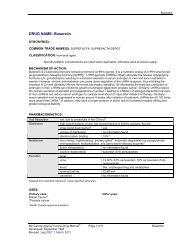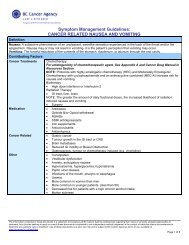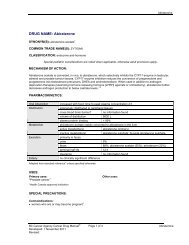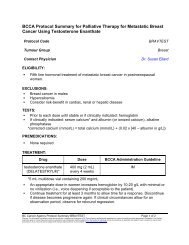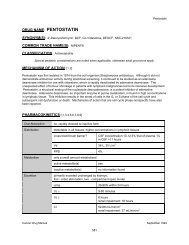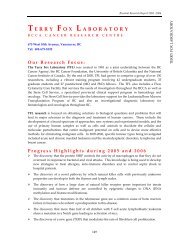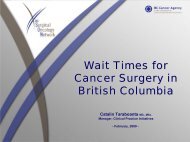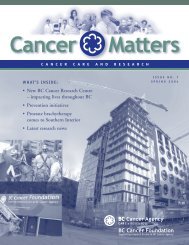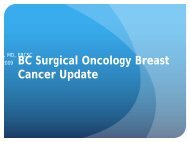Contra-indications for Sentinel Lymph Node Biopsy - BC Cancer ...
Contra-indications for Sentinel Lymph Node Biopsy - BC Cancer ...
Contra-indications for Sentinel Lymph Node Biopsy - BC Cancer ...
You also want an ePaper? Increase the reach of your titles
YUMPU automatically turns print PDFs into web optimized ePapers that Google loves.
<strong>Contra</strong>-<strong>indications</strong> <strong>for</strong> <strong>Sentinel</strong><br />
<strong>Lymph</strong> <strong>Node</strong> <strong>Biopsy</strong><br />
S Latosinsky<br />
Surgical Oncologist<br />
and Rudy Falk Clinician Scientist<br />
Why assess nodes?<br />
Prognosis<br />
Guide adjuvant therapy<br />
Regional control<br />
Survival<br />
Learning Points<br />
What is the value of axillary assessment?<br />
What are the risks of SLNB over AND?<br />
What are the contra-<strong>indications</strong> to<br />
sentinel node biopsy?<br />
Prognosis<br />
Fifteen-year Kaplan–Meier death rates by lymph node status <strong>for</strong> women.<br />
Michaelson et al, <strong>Cancer</strong> 2003;98:2133–43.<br />
3 or more node +ve<br />
1 node +ve<br />
node -ve<br />
1
Guide adjuvant therapy<br />
50% of adjuvant systemic therapy<br />
decisions need an AND*<br />
Post-mastectomy radiotherapy <strong>for</strong> node<br />
positive disease<br />
*Olivotto, <strong>Cancer</strong> 1998;83:948–55.<br />
Survival<br />
Survival benefit from axillary dissection from six randomized trials.<br />
Orr, Ann Surg Onc, 1999;6:109–16.<br />
Regional control<br />
Study<br />
NSABP B-04<br />
Fisher, NEJM 1985;312:674-81.<br />
CRC<br />
Houghton, WJ Surg 1994;18:<br />
117-22.<br />
Mid-Kent Oncology Group<br />
McKinna, Eur J <strong>Cancer</strong>, 1999;35:<br />
1065-9. Radiother Oncol, 1999;<br />
52:219-23.<br />
365<br />
1424<br />
1376<br />
311<br />
Follow-up<br />
(Years)<br />
10<br />
20<br />
10<br />
SM<br />
SM<br />
* Presence of tumour # Presence of tumour, swelling, pain<br />
N<br />
Treatment<br />
SM +RT<br />
<strong>BC</strong>S+RT<br />
Axillary<br />
Recurrence<br />
17.8%<br />
19.5%<br />
5.7%<br />
10%<br />
Why not assess nodes?<br />
<strong>Lymph</strong>edema 2 - 27% *<br />
Chronic pain 4 - 6% *<br />
*The Steering Committee on Clinical Practice Guidelines <strong>for</strong> the Care and Treatment of Breast <strong>Cancer</strong>.<br />
CMAJ. 1998 Feb 10;158 Suppl 3:S22-6.<br />
Uncontrolled<br />
Axillary<br />
Problems<br />
1.1% *<br />
6.3% *<br />
2.6%<br />
6.2% #<br />
2
*<br />
Chua (<strong>BC</strong>) #<br />
Canadian Guidelines: AND<br />
Removal and pathological examination of axillary<br />
lymph nodes should be standard procedure <strong>for</strong><br />
patients with early, invasive breast cancer.<br />
The Steering Committee on Clinical Practice Guidelines <strong>for</strong> the Care and Treatment of Breast<br />
<strong>Cancer</strong>. CMAJ. 1998 Feb 10;158 Suppl 3:S22-6.<br />
Risk of SLNB.<br />
What number is important?<br />
2003<br />
* modified from Kelley et al., Am J Surg 2004;188:49–61<br />
# Chua et al, Am J Surg 2003;185:118-26.<br />
MV<br />
547(93%)<br />
Varied<br />
88%<br />
22%<br />
92%<br />
Canadian Guidelines: SLNB<br />
Axillary dissection is the standard of care <strong>for</strong><br />
the surgical staging of operable breast cancer.<br />
If a patient requests or is offered SLN biopsy,<br />
the benefits and risks as well as what is and is<br />
not known about the procedure should be<br />
outlined.<br />
The Steering Committee on Clinical Practice Guidelines <strong>for</strong> the Care and Treatment of Breast <strong>Cancer</strong>.<br />
CMAJ 2001;165(2):166-73<br />
SLNB<br />
Risk of SLNB.<br />
What number is important?<br />
+<br />
-<br />
Total<br />
+<br />
101<br />
13<br />
114<br />
Sensitivity =89%<br />
Krag et al, NEJM 1998;339:941-6.<br />
AND<br />
-<br />
0<br />
291<br />
291<br />
Total<br />
101<br />
304<br />
405<br />
Specificity=100%<br />
PPV=100%<br />
NPV=96%<br />
3
Surgeon<br />
Omission of AND<br />
Low risk of nodal mets (
Indications <strong>for</strong> SLNB<br />
T1-2 adenocarcinoma with clinically negative<br />
axillary lymph nodes.<br />
Absence<br />
of experienced surgeon + team<br />
Surgeon experience is the most important<br />
factor in sentinel node identification.<br />
<strong>Contra</strong>-<strong>indications</strong> <strong>for</strong> SLNB<br />
Absence of experienced<br />
surgeon + team<br />
DCIS<br />
Prophylactic mastectomy<br />
Multifocal tumours<br />
Locally advanced cancer<br />
T3<br />
Inflammatory<br />
Clinically palpable nodes<br />
DCIS<br />
Previous breast surgery<br />
Previous axillary surgery<br />
Previous breast radiation<br />
Pre-op chemotherapy<br />
Pregnancy<br />
Breast feeding<br />
Allergies<br />
As 20% of core biopsies with DCIS will<br />
have invasive disease, when proceeding<br />
to mastectomy consider SLNB.<br />
5
DCIS<br />
Study<br />
Klauber-DeMore et al<br />
Ann Surg Oncol 2000;7:636-42.<br />
Cox et al<br />
Am Surg 2001;67:513-9<br />
N<br />
76<br />
224<br />
<strong>Node</strong><br />
Positive<br />
12%<br />
10%<br />
Prophylactic Mastectomy<br />
0.1- 4% incidental cancers<br />
Goldflam, <strong>Cancer</strong> 2004;101:1977-86.<br />
King, <strong>Cancer</strong> 2004;101:926–33.<br />
DCIS<br />
A 10-20% rate of nodal metastasis<br />
does not match the clinical reality that<br />
more than 98% of these patients are<br />
cured with appropriate surgical treatment.<br />
Kelley et al, Am J Surg 2004;188:49–61.<br />
Locally advanced breast cancer<br />
Wong et al, Am Surg 2001;67:522-6.<br />
6
Multiple tumours<br />
Study<br />
Layeeque et al,<br />
Am J Surg 2003;186:730-5.<br />
Tousimis et al,<br />
J Am Coll Surg. 2003;197:529-35.<br />
ALMANAC Trialists Group<br />
EJSO 2004;30:475–479.<br />
40<br />
70<br />
75<br />
<strong>Node</strong><br />
Positive<br />
63%<br />
54%<br />
45%<br />
Previous breast surgery<br />
Breast Implants<br />
N=11<br />
Identification 100%<br />
False negative rate 0%.<br />
Other Breast Surgeries<br />
Is AND appropriate?<br />
Gray et al Am J Surg 2004; 188:122-5.<br />
N<br />
SLN ID<br />
Rate<br />
100%<br />
100%<br />
94.7%<br />
FN<br />
Rate<br />
0%<br />
8%<br />
8.8%<br />
Clinically palpable nodes<br />
Common contra-indication<br />
Up to 30% false positive rate<br />
FNA node?<br />
Previous axillary surgery<br />
N=32<br />
75% identification<br />
13% positivity<br />
Gray et al Am J Surg 2004; 188:122-5.<br />
Recurrence SLNB/AND<br />
Recent failed SLNB/AND<br />
Unrelated axillary surgery<br />
69%<br />
22%<br />
9%<br />
7
Pre-op chemotherapy<br />
Bland, Breast J. 2003;9:374-9.<br />
Summary<br />
<strong>Contra</strong>-<strong>indications</strong> <strong>for</strong> SLNB<br />
Absence of experienced<br />
surgeon + team<br />
DCIS<br />
Prophylactic mastectomy<br />
Multifocal tumours<br />
Locally advanced cancer<br />
T3<br />
Inflammatory<br />
Clinically palpable nodes<br />
Previous breast surgery<br />
Previous axillary surgery<br />
Previous breast radiation<br />
Pre-op chemotherapy<br />
Pregnancy<br />
Breast feeding<br />
Allergies<br />
Summary<br />
Axillary assessment in breast cancer<br />
at diagnosis is important <strong>for</strong> prognosis<br />
and adjuvant therapy decisions. It has<br />
little benefit in regional control and a<br />
possible small survival advantage.<br />
SLNB has minimal risks relative to AND.<br />
Thank you!<br />
8




